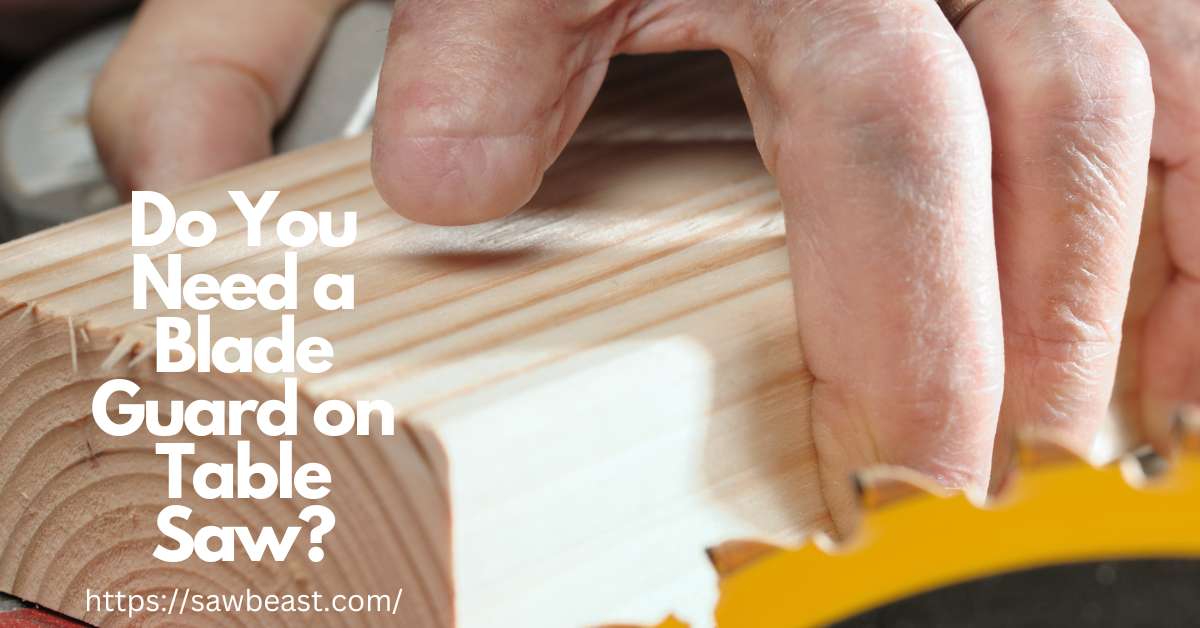With a blade running at speeds exceeding one hundred miles per hour and teeth moving toward the operator, table saws pose an extreme danger.
This creates a significant threat to operators, as the blades have the potential to cause injuries such as severed fingers and eye damage due to splintering.
The best-quality table saws available today come equipped with built-in safety features that significantly minimize the risk of injuries.
One key safety feature is the blade guard—a transparent cover made of plastic that encloses the rotating blade from all sides, providing essential protection.
While almost all table saws in the market include this safety feature, many users still prefer to operate the table saw without the blade guard.
This article will explore whether the blade guard is a must-have safety feature or if operating the table saw without it is a viable option.
Why Do You Need a Blade Guard on Table Saw?
As mentioned earlier, the blade guard is an indispensable safety feature.
It covers the sharp, rotating blade from the top, bottom, left, and right, allowing users to work safely and minimizing the risk of injury, especially in the case of kickbacks.
Furthermore, the transparent nature of the blade guard provides a clear view of the blade, enabling users to discern the cutting direction for enhanced accuracy and precision.
Accidental cuts to the hands and fingers, however, are not the sole reason the blade guard is necessary.
It serves several other crucial purposes, including the protection of your eyes.
In addition to shielding your hands, the blade guard prevents wood chips and small pieces from flying into the air and causing eye damage, which could even lead to blindness.
Moreover, some wood chips may drop onto the fast-spinning blade, propelling them towards you at incredible speeds.
Blade guards are essential in redirecting these wood chips away from you, thus minimizing the risk of eye damage.
Furthermore, blade guards play a vital role in maintaining a clean working environment.
Most blade guards come equipped with a dust collection port that gathers dust particles during cutting.
These particles can otherwise pollute the workspace and pose a risk to your eyes, causing irritation and blurred vision.
Difference between Riving Knife and Blade Guard
Many people confuse the blade guard with the riving knife, and they may remove the blade guard, believing that the riving knife alone is sufficient for ensuring safety.
In older table saw models, these components were often combined as a single piece.
While it is true that both the riving knife and the blade guard contribute to the operator’s safety, they serve entirely different roles.
The riving knife is positioned at the back of the blade and plays a crucial role in preventing kickbacks.
On the other hand, blade guards enclose the blade from all sides, preventing injuries that could result from kickbacks.
They ensure that no wood piece gets trapped between the fast-spinning blade or becomes a projectile that could fly into the eyes of the operator.
It is important to note that both the riving knife and the blade guard are equally vital for your safety and well-being, and neither should be removed.
Is it Safe to Use a Table Saw without a Blade Guard?
You may have come across many woodworkers on YouTube providing tutorials on removing the blade guard.
However, this is not a wise decision, especially for novice woodworkers with limited experience.
While it’s true that working with a blade guard can be uncomfortable and may compromise accuracy, it’s crucial not to remove the blade guard because accuracy should not take precedence over safety, particularly when it comes to protecting your fingers.
Working without a blade guard and without proper safety precautions significantly increases the risk of finger injuries. Therefore, it is strongly advised not to take such a risk.
In certain situations, you may consider removing the blade guard, but it’s essential to exercise extreme caution.
Below, we have listed the most common situations in which blade guards may not be required.
1. When Using Push Blocks
Woodworkers employ a push block as a safety measure when performing rip cuts.
The push block guides you to make straight cuts as it slides across the workpiece and over the blade.
The presence of a blade guard can hinder the movement of the push block. Moreover, the push block also serves to protect the fingers from the sharp blade.
Therefore, there may be less need for the blade guard, and you can consider removing it.
2. Performing Angled Cuts
Angled cuts require great precision. For this purpose, the blade needs to be angled, causing the blade guard to come in contact with the table saw’s surface.
This contact prevents the user from accurately positioning and angling the blade, dramatically compromising precision.
Therefore, the blade guard must be removed to perform such cuts with accuracy.
3. When using Dado Blades
Dado blades, especially stacked dado blades, are a series of blades combined to create a broader blade for performing non-through cuts.
These cuts involve making slots in wooden boards without splitting the board into two; in other words, they partially cut the board.
Since the dado blades used for these cuts are much broader than regular blades, using the blade guard can prevent them from getting in the way and enable you to perform cuts more comfortably.
4. When using cross-cut sleds
Another instance where blade guards are not required is when using jigs or cross-cut sleds.
These sleds are designed to ensure clean and perfectly accurate cuts each time.
However, the presence of a blade guard can interfere with their functionality.
5. When performing narrow cuts
Many woodworkers often complain about the blade guard getting in their way, making it challenging to perform accurate and precise cuts.
This is one of the primary reasons why they choose to remove blade guards.
When making narrow cuts, it is necessary to position the blade extremely close to the rip fence.
However, the blade guard can make this task difficult. Therefore, you can consider removing the blade guard when you need to perform narrow and angled cuts.
Apart from these instances, ensure that your blade guard is functioning appropriately.
Conclusion
The blade guard is a must-have safety feature for your table saw.
This plastic cover keeps the fast-spinning blade at a safe distance from your hand, ensuring no injuries to your hands or fingers.
Moreover, blade guards help maintain a clean working environment and protect your eyes from damage. Thus, removing the blade guard is out of the question.
However, there are instances where using a table saw without a blade guard is acceptable.
These instances include when you are performing angled or narrow cuts, using dado blades, or employing push blocks and sleds.
Nevertheless, never compromise your safety by removing the blade guard. Your safety must always be your top priority.

